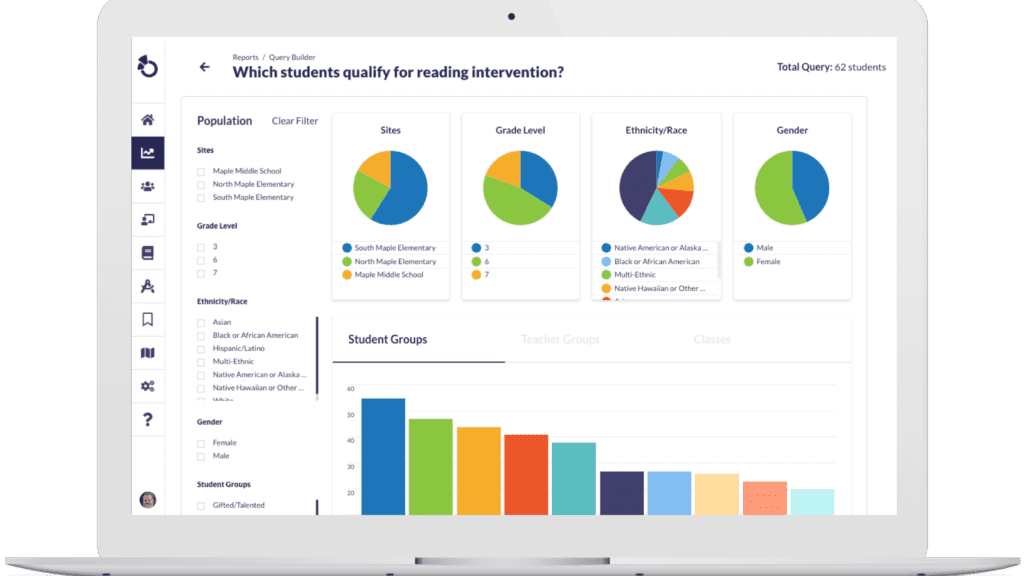The Edtech Guru Podcast: AI & Data-Driven Insights in Education with Chris Hull
By: Otus Team
Chris Hull has lived on both sides of the desk—seventh-grade teacher and edtech executive—and his view of AI starts squarely in the classroom. In this episode of The Edtech Guru, he joins host Leena Marie Saleh to talk candidly about how AI-powered insights, unified data, and smarter tools can actually make teaching feel more sustainable. The conversation covers everything from the chaos of early 1:1 devices to why “free” tools often cost more in the long run, and what it really takes to give teachers back time while keeping students at the center.
3 big takeaways for K-12 educators
Effective edtech starts with the student, not the software
Most tools are built around courses, classes, or content. Otus flips that. Everything begins with a comprehensive student profile, including past performance, standards attempts, diagnostics, notes, and more. Teachers can see growth, compare consistently, and understand where each learner is starting. As Chris explains, that shift mirrors how real classrooms work: progress builds skill by skill, year by year.
“When you look at a traditional learning management system, you would have a syllabus, a course, and a plan of how it's going to go. You would teach the same section over and over again, and you manage the resources, the progression, the sequence, and the scope. But with Otus, it's about the student. In higher education, if you miss two weeks, well, that's on you to catch up. In K-12, it has to be about the kid, meeting them where they're at, and being able to understand how to engage with them—because without the students engaged, the learning can't happen.”
Data becomes powerful when it strengthens teacher intuition
Teachers already gather meaningful qualitative insights every day. Data isn’t there to override that judgment; it’s there to clarify it. When learning evidence is broken down by skill, standard, or trend, it becomes easier to pinpoint what a student needs and communicate it clearly to colleagues and families. When Chris was a teacher, this kind of visibility helped him understand not just how students were performing, but why, and what needed to happen next.
“I always say data is a four letter word. It doesn't mean though that it can't be used in the right way. I don't think we should be data blind. There are students who might be struggling with tests or having anxiety but there's something there that's going to unlock that. You might be able to say, ‘Hey, they’re crushing formative tests but struggling on the diagnostic. What is it?’ Well then you might want to look at like how many days they’re missing, what's their behavior, or how are they feeling that day. There's some type of evidence that needs to be unlocked”
“Data is information to paint a more complete picture. The teachers who are in a classroom are going to have this feeling of how it's going, but we need to be able to make it tangible for that articulation of what's happening for the other teachers. ‘In my classroom they're doing great.’ Okay, well we have to talk more than the quality; like what's really happening? And when they go from sixth grade to seventh grade to eighth grade, how do we articulate that? And then at the administrative level, how do we get these insights for the groups of kids?
And I think that's really where data is so transformative because it allows you to take something that can be done at a small scale, connecting to a handful of kids, and make an impact that can be much larger because you can communicate it. But it also allows you to really be able to scale it so that more than just you are able to do it and so that you're able to connect more and then your entire school and district are able to do it and be able to help more and more kids.”
Chris Hull
Co-founder and President
,
Otus
“I think in instruction, we sometimes don't want to label a kid with a number. But we want to be able to have this wide range of data with some qualitative and with a lot of quantitative, and with that wide range we can paint such a more complete picture, so then we can really pinpoint what has to happen.”
AI’s biggest role is a teacher’s “assistant”
The most useful applications of AI aren’t flashy, but supportive. AI can translate complex data into plain language, surface patterns that might otherwise be missed, summarize progress, or help teachers check their own thinking: “Am I reading this right?” As Chris puts it, AI should feel like having a few graduate assistants beside you, handling the analysis so teachers can focus on connection, instruction, and those moments of joy that spark learning.
“Instead of having to look at a graph or a visualization, How great would it be to have the ability to just ask the question, ‘How are my students doing on this standard? What could I do next on this standard?’ And it's just using your natural language ability to be able to get those answers. Technology really needs to be a tool that supplements what a teacher can do. If we can augment these administrative tasks, augment the data analysis, then there's more time for what's never going to be replaced, which is connecting to students.”
Related Resources
Request a demo!
See exactly how Otus can help your school accelerate student growth and improve student outcomes – all while saving educators time.




